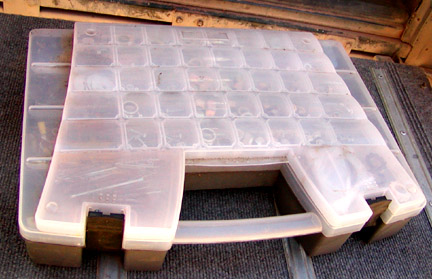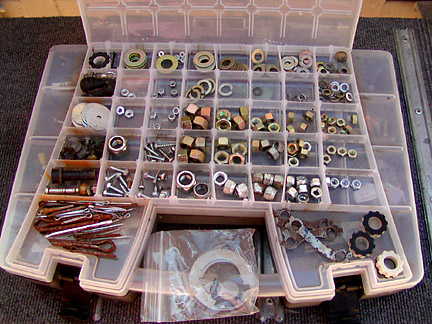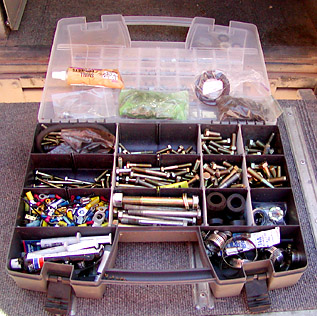|


A
number of people have asked me what I carry on long trips to give
them a starting point for developing their own tools and spares
kit. While I carry tools and spares, I consider them less important
than preventing a breakdown before it happens.
I can not over emphasize the importance of finding and correcting
potential breakdowns before going out in the field.
Before going on long trips or offroading, I make a pre
trip inspection.
While on a trip, I frequently check fluids and make visual inspections.
When I return from an offroad or major long distance trip I make
a post trip inspection to
check for and repair any damage that may have occurred on the trip.
The goal of these inspections is to prevent problems and to locate
any developing problems and correct them before they become major
problems. I carry spares and tools on my trips so that I can make
these inspections and correct problems along the way.
Tool kit
You will need a dry place to keep the tools so they will not rust.
I use a small ammo box.
Consumables
- RTV - I use the blue RTV that comes in the silver tube.
- Shop towels
- Insulated wire - About 10 to 20 feet insulated wire #12
AWG
- Electrical tape
- Brake fluid - DOT4 or DOT5 depending upon what fluid
is in the system.
- 90 wt oil and pump
- Engine oil
- Grease gun along with a supply of grease - Whenever you
wade your car water gets into the 'U' joints and tie rod ends.
Regreasing them after wading forces the water out. You also will
want to grease your fittings more frequently if making long trips
across very dusty or sandy terrain.
- Bailing Wire - About one three wire bale's worth
- Sandpaper - one sheet of fine sand paper for cleaning
electrical connections.
- Fuses - a spare box containing at least 2 of each fuse
size in your car
- Electrical connectors - I carry an assortment of crimp
on connectors that I use in my car in case one comes loose. I
also carry enough to make emergency circuit bypass wires. I have
a selection of new Lucas barrel connectors and Lucas style solder
on connector ends.
-
Bolts - You can't carry every size
and length. After loosing essential bolts that I did not have
replacements for a few times I have put together an extensive "fixings kit" that
fits into a container with lots of dividers. I have spent well
over US$ 100 to fill the kit with four grade 8 versions of
every bolt, nut and washer I can think of that is on my Land
Rover. This includes special Land Rover lock tabs, leaf spring
pack bolts and cotter pins.

Bolt box closed
. The box has two levels of compartments

This is the top level that contains grade 8 nuts, lock washers,
flat washers, fender washers, cottar pins (Including one that
fits the scuttle vent) , assorted screws, hub washers
and seals, hinge kit, tyre air nipples and such.

This is the bottom compartment which
contains an assortment of grade 8 bolts, special Land Rover fixings,
spare brake hose, electrical connectors, hose clamps,
shock bushings, special leaf spring bolts, special fixings and
assorted glues & goops.
Spare parts
You should rotate your spare parts, using them on your car next
time you need them then buy new ones for spares. Hoses coated with
talcum powder and put into zip lock bags will remain good for a
long time. Wrap your new fuel and water pumps in oiled rags then
seal them into bags to keep moisture out. The rest of the stuff
should be packed into zip lock bags where possible to keep moisture
out.
- Tune up kit - A new set of spark plugs, distributor cap.
rotor, points and condenser.
- Spark plug wires
- Ignition coil
- Fuel filter
- Oil Filter
- Gasket - for fuel pump sediment bowel
- Water pump and gasket
- Hoses - Top and bottom radiator hose, and length of heater
hose equal in length to your longest heater hose
- Hose clamps - Two of each size you use
- Rear 'U' bolts - Two new rear 'U' bolts with fixings.
Yes they can break.
- Carburetor rebuild kit
- Fan belt
- Spare rear axles - Unless you are using the stronger
Salisbury axles
- Engine mounts - Two new diesel engine mounts plus new
grade 8 fixings. Engine mounts are most likely to break under
extreme offroading. I prefer the stronger diesel engine mounts
to the petrol mounts. The transmission uses the same mount. Remember,
you can not replace them unless you carry a jack that can lift
the engine or transmission off the frame.
Lastly
If you are not well versed on working on your car, bring the workshop
manuals. If you may be near a phone, bring a parts catalogue, phone
numbers for at least two mail order parts houses and a credit card.
Remember, the very best break down is the one you prevented
before you left on the trip.
Return to page top
|
